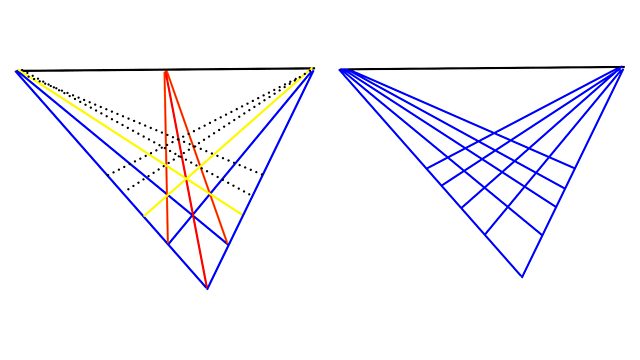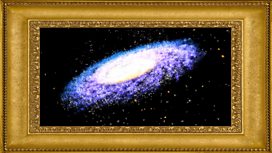Design and Beauty
Design is everywhere - from tables and chairs to quantum physics. Does it have to be beautiful? Bridget Kendall and guests discuss.
How far can we stretch the notion of a beautiful design? And, how fundamental is it to the world around us and our search for the answers to life's mysteries? We delight in beauty when we find it in the design of everyday objects. It's incorporated in the bodies we are born with and the ways we enhance them. And, on a cosmic scale, there is beauty in the rules which govern the universe. Bridget Kendall is joined by nobel prize winning physicist Frank Wilczek, furniture designer Khalid Shafar and body architect Lucy McRae to explore the frontiers of what beauty in design can mean.
(Photo: Basic perspective construction by Frank Wilczek).
Last on
More episodes
![]()
Beauty at the heart of the universe
Frank Wilczek explains why he started to seek beauty in the quantum physics. Photo: 91�ȱ�
Professor Frank Wilczek
Frank Wilczek is the Herman Fesbach professor of Physics at
MIT, Massachusetts Institute of
Technology and is generally considered to be one of the world's most eminent
theoretical physicists.
He is known, among other things, for the discovery of
asymptotic freedom, the development of quantum chromodynamics, the invention of
axions, and the exploration of new kinds of quantum statistics (anyons). Much
in demand for public lectures to a wide range of audiences, Frank has been
anthologized in the Norton Anthology of Light Verse and twice in Best American
Science Writing (2003, 2005). He is the author of Longing for the Harmonies and
The Lightness of Being.
In 2004 he received the Nobel Prize in Physics, and in 2005
the King Faisal Prize.
His latest book: A Beautiful Question, Finding Nature’s Deep
Design argues that beauty is at the
heart of the logic of the universe, a principle that has guided his pioneering
work in quantum physics.
Frank explores the idea of beauty in theoretical physics and
whether you can say such a subjective notion, which some scientists find
controversial, is describable.
Professor Wilczek’s current work:
Currently Frank is working on several projects including two very different things to do with perception. Firstly, colour perception; how much our colour perception drawn from evolution leaves ‘on the table’ and how we might get it back and how software and hardware might help us retrieve this detection of colour, including infrared and ultra violet. Secondly, perception in the quantum world. Lots of structure, says Frank, in quantum equations is at present inaccessible. We can describe the micro world but not the quantum world very well. He predicts a new kind a matter called enyons, which might also be useful for building quantum computers. Current experimental technique is not delicate enough. People can’t verify it, even though the equations tell you it’s there. Frank is trying to come up with a strategy to nail it down and explore the quantum world with more refinement.
Khalid Shafar
The last couple of years have seen Khalid Shafar emerge as a
figurehead for Emirati design. He is one of the few UAE design professionals to
be known both locally and internationally.
In 2011 Khalid opened his own studio in Dubai, and in November
2012 he started his first showcase space
‘KASA’. Khalid’s approach to design
encompasses his personal expression of form, movement, emotion, and in
particular, ‘the tale’, or story, of objects.
KASA is in the heart of the old Ras Al Khor industrial area
of Dubai.
KASA aims to showcase original Emirati objects – all
designed and made in the UAE. The space will offer designers, collectors and
researchers, both national and international, a unique perspective of the
aesthetics of UAE design, while shedding light on the influences of local
crafts upon it.
Khalid is interested in the story designs tell us and
explains how he feels beauty is
important but for him is secondary to
form and function.
Lucy McRae
Lucy McRae is a science fiction artist, director and self-proclaimed
body architect probing the frontiers of the body, health and human
adaptability. Her work aims to connect science with the imagination.
"... I look for beauty in the biological responding to
future scenarios like space travel to radically transform the life sciences. I
want to spearhead a health revolution and impact the way people embody the
future... "
Trained in classical ballet and interior design Lucy’s
artistic study of technology began during her formative years at Philips
Design. She led the technology company’s far–future research lab developing
stretchable electronics, an electronic tattoo and a range of emotional sensing
dresses awarded TIME’s Best Inventions of 2007.
“... I am willing to go far, for an experience or understanding
and look to the fringes of culture for inspiration and criticism. Provoked by
complex problems faced by scientists, physicists and mathematicians I love
impossible challenges – the further out the better... "
Lucy talks about how our perceptions of beauty may change as
we evolve and travel in outer space.
Broadcast
- Sat 14 Nov 2015 11:0091�ȱ� Radio 4


